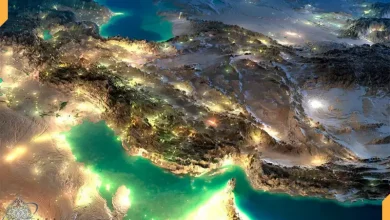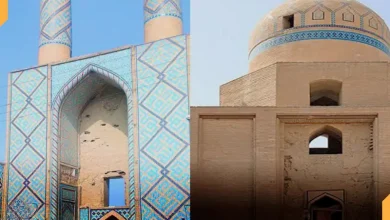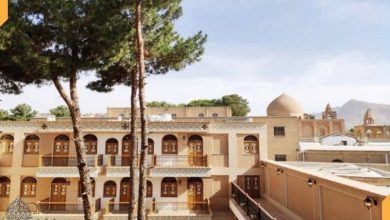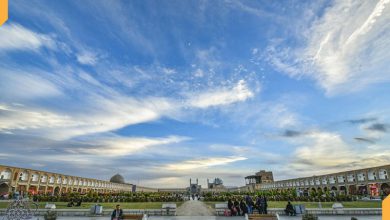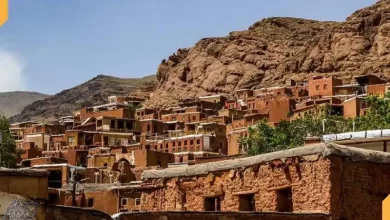The 6 historical places in Isfahan

Isfahan, one of Iran’s ancient towns, is one of the historical places in the country that draws a large number of tourists from all over the globe each year for its tourism offerings.
With its rich history, historical sites, and distinctive culture, this city contains monuments and sights that have earned it a position among Iran’s historic sites and the world’s national monuments.
It is noteworthy that this city has always been a top priority for rulers throughout history.
Because this city has always piqued the curiosity of tourists and visitors, we chose to speak about it more extensively and present to you the historical places in Isfahan. We want to invite you to accompany us on this adventure.
Unique and historical places in Isfahan
1- Naghshe – Jahan Square
Naghsh Jahan Square, one of the biggest and most beautiful squares globally, is a famous historical place in Isfahan. It is also one of the most visited historical sites in Iran.
This enormous square is 507 meters long and 158 meters broad.
The exciting thing about it is that it is home to four ancient landmarks of Isfahan, including the Sheikh Lotfollah Mosque, the Imam Mosque, Qaisaria Bazaar, and Aali Qapo Palace, respectively.
Another notable feature of this square is that it is bordered by around 200 two-floor chambers, which has enabled tourists to come to this square for both sightseeing and shopping purposes.
The creation of this square goes back to the time when the Safavid Empire selected Isfahan as their capital. During this period, the Imam Mosque, Sheikh Lotfollah Mosque, and the entrance to Qaisaria Bazaar were all constructed as part of the city’s expansion.
2- The Aali Qapu Palace
One other location worth seeing in Isfahan is the Aali Qapu Palace, situated in Naghsh Jahan Square, which we discussed earlier in the article; and in front of the Sheikh Lotfollah Mosque is one of the most impressive structures in Isfahan is the Sheikh Baha’i Bath, which is one of Iran’s most ancient and distinctive baths and dates back to the Safavid era, and also the historical place in Isfahan.
It is possible to state categorically that this Palace is a masterpiece of Safavid architectural design. When Iran’s capital was relocated from Qazvin to Isfahan during the Safavid Empire, the Shah received several nobles and significant people at this Palace.
In terms of the Qapo High Palace building, it should be noted that it was constructed on six levels, with each level featuring its unique set of decorations.
The Sound Room, located on the sixth level of the Palace, is a large hall. This hall is constructed so that, similar to a recording studio, it eliminates further echoes from the sound and distributes the sound evenly across the hall’s various zones of operation.
There are lovely and unique designing’s in every corner of this hall.
3- Hasht – Behest Mansion
The Hasht Behesht residence, which was constructed by the Safavids and given to the people of Isfahan, is one of the most magnificent and elegant historical places in Isfahan. At the end of the monarchy, this mansion served as the official home of the emperors.
An extensive and highly magnificent garden of the Naghshe – Jahan square surrounds Hasht Behesht Mansion, initially constructed by Shah Ismail and now owned by the Hasht Behesht Foundation.
Even though this mansion is octagonal, it is constructed on two floors and has four distinct faces, none of which are identical.
According to the retellings, the northern perspective is the primary view of the mansion, yet, the pool on the east side demonstrates that the main view is on this side of the estate. It is impossible to state the primary point of view with certainty.
The diamond pool is a marble octagonal pool located in the centre of the grand hall, and it is named as such because of its pearl-like appearance.
The doors and windows of this mansion are similarly inlaid, adding to the overall magnificence of the structure.
4- Chehel Sotoon Palac
Chehel Sotoon is another beautiful and historical place in Isfahan, and it is considered one of the top tourist destinations in the city.
With its stunning architecture, this historical site captures the attention of every visitor who comes to admire its splendour.
Chehelstoon, Isfahan, was a gathering location for foreign diplomats and ministers and a royal centre for the Safavid administration, and it is still in use today.
Artwork and decorations in the many rooms of the Palace represent the pinnacle of Safavid art, and its objective was to dazzle visiting diplomats from throughout the world.
Originally built during the era of Shah Abbas I, the Chehel Sotoon or Chehelston Palace in Isfahan was finished and enlarged under the reign of Safavid kings, such as Shah Abbas II, and is now known as the Chehel Sotun Museum.
Because it is situated amid a stunning waterfall, this Palace has produced spectacular visual effects.
This structure has forty columns, and just twenty columns are one of its most stunning features. However, its reflection in the royal fountain has resulted in the formation of forty columns.
You could wonder why the number forty was selected to be used in the design of this castle. In the Shia faith, the number forty is considered sacred, and it was pushed by the Safavid rulers, which was also the official religion of the ruling family at the time.
5- Sio Se Pol
Sio Se Pol Bridge, also known as Allah-Verdikhan Bridge, is another historical place in Isfahan constructed on the Zayandehrud River by Shah Abbas Safavid.
It has 33 spans and was erected on the banks of the Zayandehrud River. Allah- Verdi Khan was commissioned to finish the Bridge’s construction in 1008 A.H. Three years later, the Bridge was finally completed.
Here, the Safavids held water sprinkling rituals and the Armenian rites of the city, which took place during this era.
The Sio Se Pol Bridge, considered one of the world’s most incredible bridges and a marvel of Iranian and Safavid construction, is a must-see attraction.
Nobody can visit Isfahan and not be aware of the Bridge that runs through the city’s core.
In terms of the Bridge’s length and width, it should be noted that the Bridge is 295 meters long and 14 meters broad, and it was added to the Iranian national monuments list on December 6, 1961, as number 110.
6- Sheikh Bahia bathhouse
One of the most impressive structures in Isfahan is the Sheikh Baha’i Bath, one of Iran’s most ancient and distinctive baths and dates back to the Safavid era; and the historical place in Isfahan.
The secret of this bath’s warm water is well-known among its people. It was usually necessary to heat the bathwater with just a candle.
Sheikh Baha’i, a famous Iranian sage and scientist, was responsible for the design and construction of the bath.
Despite their efforts, scientists have not yet been able to unravel the puzzle of how to warm bath water using just a candle, and this continues to be a mystery.
Even though just one candle heated the bathwater tank till the middle of the Pahlavi era, some foreign experts attempted to find out how it worked and accidentally damaged part of the leading bath equipment.
This bath has now been converted into a museum, and visitors can visit it.
7- Pole Khajoo
The Zayandehrood river is crossed by the Khajoo Bridge, which has 24 decks and is located east of the Sio Se Pol.
According to legend, this Bridge was constructed during the reign of Shah Abbas II in 1060 AH and now is the historical place in Isfahan.
On this Bridge’s middle span, a unique structure known as “Bigerbiki” was constructed for Shah Safavi and his family to use as their temporary dwelling while they were on tour.
Awe-inspiring architecture and tiles adorn the Bridge, 133 meters long and 12 meters wide.
There are various names for Khajoo Bridge. However, most people refer to it as Khajoo since it is situated in a neighbourhood with the same name.
On the eastern side of the Bridge, there are two stone lions in the corners, which are said to be a sign of the Bakhtiari forces, who were the guardians of the cities of Isfahan and Zayandehrud at the time.
On January 6, 2013, the number 111 was assigned to this work, and it was officially included in Iran’s list of national works.
Conclusion
As we previously said, Isfahan is one of Iran’s most renowned and ancient towns, attracting thousands of visitors each year to its historical sites.
It contains many historical monuments that have survived from the Abbasid and Safavid centuries up to the present day and have undergone several restorations.
In this post, we have discussed seven very well-known situations and offered explanations for them so that you can obtain a better understanding of them.
We hope that you have found the information given about the historical places in Isfahan to be helpful. You will have a wonderful time seeing the ancient city of Isfahan if you decide to visit there.


